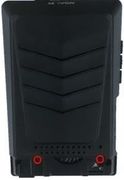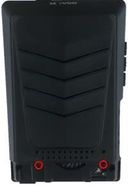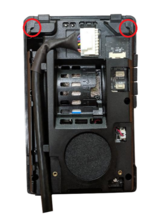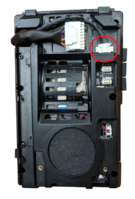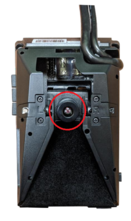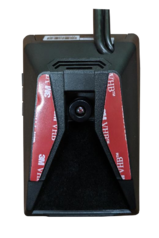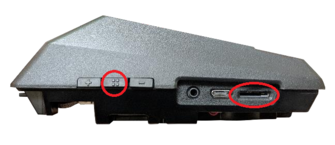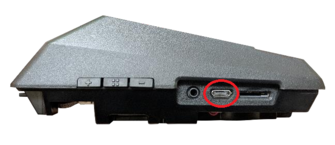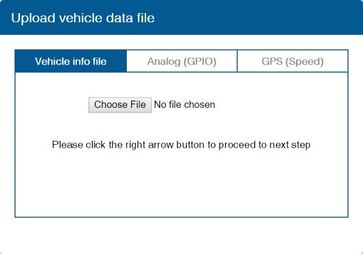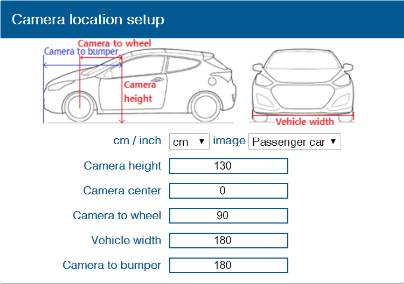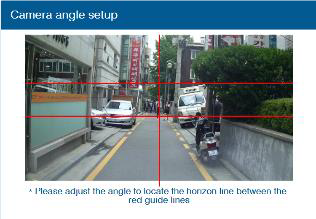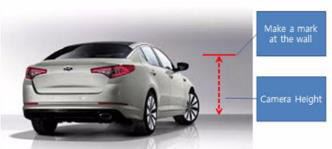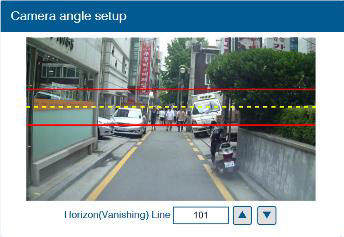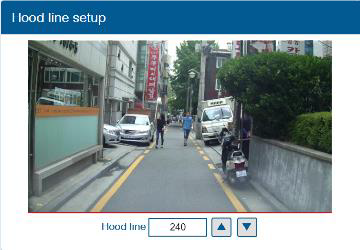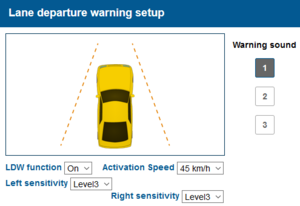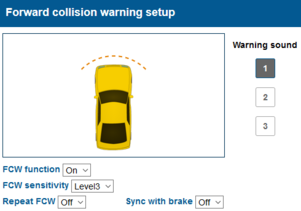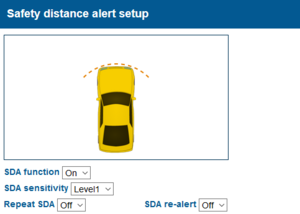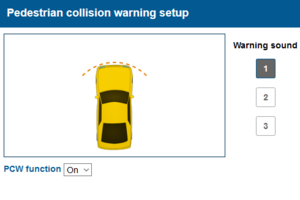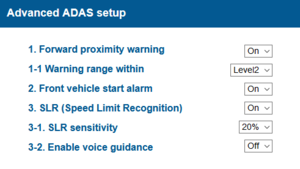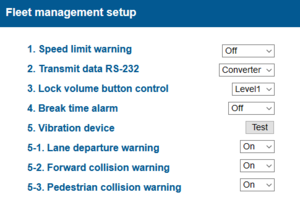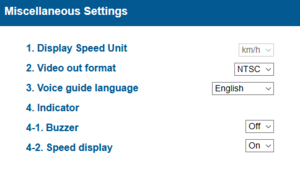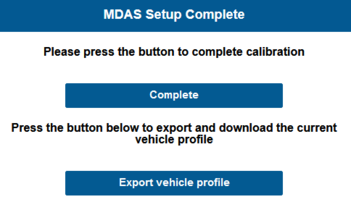Difference between revisions of "ADAS Camera Manual"
MindaugasK (talk | contribs) |
|||
| (11 intermediate revisions by 2 users not shown) | |||
| Line 1: | Line 1: | ||
__TOC__ | __TOC__ | ||
| + | == Main (front) camera unit preparation == | ||
| + | The main unit comes prepared for bus/large truck setup (cable routing) or vehicles with mostly vertical windshields''.'' To set up the unit for an average truck or passenger vehicle, dismantle partially as shown below: | ||
| + | {| class="wikitable" | ||
| + | |+ | ||
| + | ! colspan="6" |Unit preparation | ||
| + | |- | ||
| + | |[[File:Camera1.jpg|center|frameless|181x181px]] | ||
| + | |1. Remove cover | ||
| + | |[[File:Camera1.jpg|center|frameless|186x186px]] | ||
| + | |2. Remove (2x) screws, | ||
| + | remove plastic cover | ||
| + | |[[File:Camera3.png|center|frameless|216x216px]] | ||
| + | |3. Remove (2x) screws, | ||
| + | pry plastic mounting | ||
| + | |||
| + | frame off Unit from corners | ||
| + | |- | ||
| + | |[[File:Camera4.png|center|frameless|199x199px]] | ||
| + | |4. Reroute the main | ||
| + | cable (and rear camera | ||
| + | |||
| + | cable, if adding) around unit | ||
| + | |||
| + | to front (glass side) | ||
| + | |[[File:Camera5.png|center|frameless|221x221px]] | ||
| + | |5. Press tightly into | ||
| + | channels when routing cables. | ||
| + | |||
| + | Remove front camera dust sticker | ||
| + | |[[File:Camera6.png|center|frameless|238x238px]] | ||
| + | |6. Replace 1 cover only | ||
| + | removed from step 3. | ||
| + | |||
| + | Replace 2 screws. | ||
| + | |||
| + | Leave the remaining | ||
| + | |||
| + | covers off until the last step | ||
| + | |} | ||
| + | |||
| + | ==ADAS Calibration== | ||
| + | ADAS Calibration requires: | ||
| + | |||
| + | *a laptop with an internet connection and a browser | ||
| + | |||
| + | *micro-USB cable | ||
| + | |||
| + | *tape measure | ||
| − | + | *parking the car with a clear, open stretch of about a 45 meters unobstructed view (try to park close to your facility to keep the internet connection accessible – at least during the calibration driver installation) | |
| − | + | *a partner to drive the vehicle while speed correction is performed | |
| − | + | ||
| − | + | Before beginning, insert the provided micro-SD card into the main unit in the location shown below until it clicks and turn the Ignition ON. Wait for the prompt, then press and release the center button one time. After the successful prompt and the unit reboots, continue to step 1. | |
| − | + | [[File:Vehinst12.png|center|frameless|335x335px]] | |
| − | + | ||
| − | + | 1. Park the vehicle in a spot with a clear stretch of unobstructed line-of-sight (about 45 meters). Leave the vehicle running | |
| − | + | 2. Connect the USB cable to the Mirco-USB port on the side of the main unit (windshield) and the other end to the laptop. If on a windows 10 machine, it should automatically install the required driver. If not or on an older machine, go to movon.co.kr, go to the ‘ADAS’ tab at the top then to ‘Downloads’ under Support. Download the appropriate zip file (contains driver) and extract it fully for your version of Windows OS (if using the 7/8 driver, install the .exe file). If WIN10, once downloaded, disconnect/reconnect the USB and it should automatically install, or find the unit in Device Manager and right-click, Update Driver and browse for driver locally.[[File:Vehinst13.png|center|frameless|335x335px]] | |
| − | + | 3. Open Chrome browser again and type in ''’10.0.0.1’'' into the URL bar''.'' If the driver was installed properly, the calibration screen will appear. Input credentials and press ''LOGIN'' USER: ''admin'' PASS: ''1234''<br> | |
| − | + | 4. '''Select Vehicle Signal Type:''' there are several wiring options for installation: CAN-BUS / Analog (GPIO) / GPS (Speed). Select the proper calibration option based off which was installed: CAN (if CAN file is available), Analog (if analog signals were tapped) | |
| − | + | ||
| − | + | '''''Vehicle Data File''''' (CAN-BUS)For CAN-BUS connection, choose the ‘Vehicle info file’ tab and select ‘Choose File’ to upload the previously downloaded ‘mdasinfo.dat’ file (see ‘CAN-Equipped vehicles’ section). | |
| − | + | [[File:Vehinst14.jpg|center|frameless|363x363px]] | |
| − | + | ||
| − | + | ==Camera location and Vehicle Measurement== | |
| − | + | Camera location and vehicle measurement can affect ADAS performance. It`s very important put accurate data for the best performance. | |
| − | + | [[File:Vehinst15.png|center|frameless|404x404px|alt=]] | |
| − | |||
| − | |||
| − | |||
| − | |||
| − | |||
| − | |||
| − | |||
| − | |||
| − | |||
| − | |||
| − | |||
| − | |||
| − | |||
| − | |||
| − | |||
| − | |||
| − | |||
| − | |||
| − | |||
| − | |||
| − | |||
| − | |||
| − | |||
| − | |||
| − | |||
| − | |||
| − | |||
| − | |||
| − | |||
| − | |||
| − | |||
| − | |||
| − | |||
| − | |||
| − | |||
| − | |||
<table class="nd-othertables" style="width: 68%;"> | <table class="nd-othertables" style="width: 68%;"> | ||
| − | <th style="width: 10%; text-align:left; vertical-align:middle; color:black"> | + | <th style="width: 10%; text-align:left; vertical-align:middle; color:black">Camera Option</th> |
<th style="width: 20%; text-align:center; vertical-align:middle; color:black">Description</th> | <th style="width: 20%; text-align:center; vertical-align:middle; color:black">Description</th> | ||
</tr> | </tr> | ||
<tr> | <tr> | ||
| − | <td style="width: 8%; text-align:left;"> | + | <td style="width: 8%; text-align:left;">Camera Height</td> |
| − | <td style="width: 8%; text-align:left"> | + | <td style="width: 8%; text-align:left">Distance from ground to the center of camera lens.</td> |
</tr> | </tr> | ||
<tr> | <tr> | ||
| − | <td style="width: 8%; text-align:left"> | + | <td style="width: 8%; text-align:left">Camera Center</td> |
| − | <td style="width: 8%; text-align:left"> | + | <td style="width: 8%; text-align:left">Distance from the center of windshield to camera lens |
| + | “-“: Left Side / “+”:Right Side | ||
| + | |||
| + | (If ADAS is attached 5cm to the right from the center, input 5. | ||
| + | |||
| + | If ADAS is attached 5cm to the left from the center, input -5.) | ||
| + | </td> | ||
</tr> | </tr> | ||
| − | <tr | + | <tr> |
| − | <td style="width: 8%; text-align:left"> | + | <td style="width: 8%; text-align:left">Camera to Wheel</td> |
| − | <td style="width: 8%; text-align:left"> | + | <td style="width: 8%; text-align:left">Distance from the camera to the center of the wheel. |
| − | + | '''For trucks or buses''', some vehicles’ wheels are located behind. | |
| − | |||
| − | + | In this case, please input 20cm. | |
| − | + | </td> | |
| − | + | </tr><tr><td>Vehicle Width</td><td>Distance between the wheels. | |
| + | Measure distance from left outside boarder to right outside boarder of the wheels. | ||
| + | </td></tr><tr><td>Camera to bumper</td><td>Distance from the camera lens to the end of the bumper. | ||
| + | For trucks or buses, it is recommended to input 300 if sensitive FCW warning is needed. | ||
| + | </td></tr></table> | ||
| − | + | Camera angle – adjust the camera angle to locate the horizontal between the red guide lines. | |
| + | [[File:Vehinst16.png|center|frameless|316x316px]] | ||
| + | In case of indoor installation or somewhere you cannot see the horizon properly, use same data to "'''Camera Height'''”. Mark the same height on the wall apart about 3 ~ 5 meters from the vehicle. | ||
| + | [[File:Vehinst17.png|center|frameless|332x332px]] | ||
| − | [[File: | + | Fine Camera Angle - For better accuracy of ADAS, locate the yellow dotted line in the horizon as close as possible. |
| + | [[File:Vehinst18.png|center|frameless|344x344px]] | ||
| − | + | Hood Line - Locate the red line at the end of the vehicle’s hood line to remove the useless area. | |
| + | [[File:Vehinst19.png|center|frameless|360x360px]] | ||
| + | Please follow link for video instruction: https://www.youtube.com/watch?v=93wrc6j9aqA | ||
| − | You can | + | ==ADAS camera settings configuration== |
| + | {| class="wikitable" | ||
| + | | colspan="2" |'''You can adjust the LDW Sensitivity for your convenience''' | ||
| + | |- | ||
| + | | | ||
| + | * Enable LDW function. (On / Off) | ||
| − | + | * Set the Activation Speed (15, 30, 45, 60, 75km/h). | |
| − | [[File: | + | * Set the sensitivity of LDW warning on a scale of 1 to 5. |
| − | + | * As the level gets higher, it gets more sensitive. | |
| + | * Enable Repeat LDW (On / Off) | ||
| + | * If it’s on, ADAS keeps warning until the driver secures the lane. | ||
| + | * Warning sound: Select preferred warning sound for LDW. | ||
| + | |[[File:Mdconfi1.png|center|frameless]] | ||
| − | + | |- | |
| − | [[File: | + | | colspan="2" |'''You can adjust the FCW Sensitivity for your convenience:''' |
| − | ''' | + | |- |
| + | | | ||
| + | * Enable FCW function. (On / Off) | ||
| + | * Set the sensitivity of FCW warning on a scale of 1 to 5. | ||
| + | (As the level gets higher, it gets more sensitive) | ||
| + | * Enable Repeat FCW (On / Off). | ||
| + | (If it’s on, ADAS keeps warning until the driver secures safe distance) | ||
| + | * Enable Sync with Brake (On / Off). | ||
| + | (If it’s on, ADAS won’t give FCW warning if the brake pedal was used) | ||
| + | * Warning sound: Select preferred warning sound for FCW | ||
| + | |[[File:Mdconf2.png|center|frameless|301x301px]] | ||
| + | |- | ||
| + | | colspan="2" |'''Safety distance alert setup:''' | ||
| + | |- | ||
| + | | | ||
| + | * Enable SDA function. (On / Off) | ||
| + | * Set the sensitivity of SDA on a scale of 1 to 5. | ||
| + | * As the level gets higher, it gets more sensitive. | ||
| + | * Repeat SDA and SDA re-alert can be changed. (On / Off) | ||
| − | + | - Repeat SDA: If it’s on, ADAS keeps warning until the driver secures safe distance. | |
| − | |||
| − | |||
| − | |||
| − | |||
| − | '' | + | ''- Re-alert SDA: If it’s on, ADAS gives warnings every time'' |
| − | + | ''the same front vehicle gets closer than safe distance.'' | |
| − | [[File: | + | |[[File:Mdconfi3.png|center|frameless]] |
| − | ''' | + | |- |
| + | | colspan="2" |'''Pedestrian collision warning setup:''' | ||
| + | |- | ||
| + | | | ||
| + | * Enable PCW function. (On / Off) | ||
| − | + | * Warning sound: Select preferred warning sound for PCW. | |
| − | [[File: | + | |[[File:Mdconfi4.png|center|frameless]] |
| − | ''' | + | |- |
| + | | colspan="2" |'''Advanced ADAS setup:''' | ||
| + | |- | ||
| + | | | ||
| + | * Enable Forward Proximity Warning function. (On / Off) | ||
| + | * Set the warning range on a scale of 1 to 3. | ||
| + | (As the level gets higher, it gets more sensitive) | ||
| + | * Enable Front vehicle start alarm. (On / Off) | ||
| + | * Enable Speed Limit Recognition. (On / Off) | ||
| + | * Set the warning sensitivity (0, 5, 10, 15, 20%). | ||
| + | Ex) If you set 10% then you will get alarm | ||
| − | + | when your speed over the limit more than 10%, | |
| − | |||
| − | |||
| − | + | 100km limit -> Warning start from 110km speed. | |
| − | [[File: | + | * Enable voice guidance (On / Off). |
| − | ''' | + | |[[File:Mdconfi5.1.png|center|frameless]] |
| + | |- | ||
| + | | colspan="2" |'''Fleet management setup''' | ||
| + | |- | ||
| + | | | ||
| + | * Set Speed limit warning (Off, 80, 90, 100, 110, 120, 130, 140km/h). | ||
| − | + | - You can set your own speed limit for your fleet. | |
| + | |||
| + | - You can set speed limit of your vehicle and get warning if you over the speed limit. | ||
| + | |||
| + | * Enable Transmit data RS-232 feature | ||
| + | (Converter mode should be selected to work with FMx125). | ||
| + | |||
| + | It allows ADAS event data transmission to integrated device. | ||
| + | * Set Lock volume button control on a scale of 1 to 5 and Off. | ||
| + | You can fix the volume level and prevent the driver from adjusting the | ||
| + | |||
| + | settings using indicator. | ||
| + | * Set Break time alarm on a scale of 1 to 6 hours and Off. | ||
| + | |||
| + | * Enable Vibration setting for LDW, FCW, PCW (On / Off / Both). | ||
| + | You can check the connection with the button. | ||
| + | |[[File:Mdconfi6.1.png|center|frameless]] | ||
| + | |- | ||
| + | | colspan="2" |'''Miscellaneous Settings:''' | ||
| + | |- | ||
| + | | | ||
| + | * Speed Unit on Analog video output (km/h or MPH). | ||
| + | |||
| + | * Set Video out format (NTSC / PAL). | ||
| + | |||
| + | * Set Voice guide language | ||
| + | (English / Korean / Chinese / Spanish / Japanese / Hebrew/ No Sound). | ||
| + | * Enable Indicator buzzer (On / Off). | ||
| + | |||
| + | * Speed Display on Indicator could be ON/Off | ||
| + | |[[File:Mdconfi7.png|center|frameless]] | ||
| + | |- | ||
| + | | colspan="2" |'''ADAS Setup Complete''' | ||
| + | |- | ||
| + | | | ||
| + | * Click “Complete” button to finish Calibration setup. Then ADAS will be | ||
| + | rebooted automatically. | ||
| + | * Click “Export vehicle profile” button, if you want to download vehicleprofile.dat. | ||
| + | |||
| + | This vehicleprofile contains all the calibration settings you’ve set. | ||
| + | |||
| + | With this file, you can simply apply current settings to another vehicle. | ||
| + | |[[File:Mdconfi8.png|frameless|alt=|center|351x351px]] | ||
| + | |} | ||
==ADAS data transferring timing== | ==ADAS data transferring timing== | ||
| − | |||
{| class="wikitable" | {| class="wikitable" | ||
! rowspan="1" style="width: 400px; background: #0054A6; color: white;" |'''Image resolution''' | ! rowspan="1" style="width: 400px; background: #0054A6; color: white;" |'''Image resolution''' | ||
| Line 133: | Line 242: | ||
|- | |- | ||
|style="text-align: center;|640x480 | |style="text-align: center;|640x480 | ||
| − | |style="text-align: center;| | + | |style="text-align: center;|30 |
|<nowiki>-</nowiki> | |<nowiki>-</nowiki> | ||
| − | |style="text-align: center;|~ | + | |style="text-align: center;|~24kB |
|style="text-align: center;| - | |style="text-align: center;| - | ||
| − | |style="text-align: center;| | + | |style="text-align: center;|72s / 100s |
|style="text-align: center; style=" width: 150px; background: white; color: black;" |[[File:640x4801.jpg|thumb]] | |style="text-align: center; style=" width: 150px; background: white; color: black;" |[[File:640x4801.jpg|thumb]] | ||
|- | |- | ||
|style="text-align: center;|1280x720 | |style="text-align: center;|1280x720 | ||
| − | |style="text-align: center;| | + | |style="text-align: center;|30 |
|<nowiki>-</nowiki> | |<nowiki>-</nowiki> | ||
| − | |style="text-align: center;|~ | + | |style="text-align: center;|~160kB |
|style="text-align: center;| - | |style="text-align: center;| - | ||
| − | |style="text-align: center;| | + | |style="text-align: center;|180s / 230s |
|style="text-align: center; style=" width: 150px; background: white; color: black;" |[[File:1280x7201.jpg|thumb]] | |style="text-align: center; style=" width: 150px; background: white; color: black;" |[[File:1280x7201.jpg|thumb]] | ||
|- | |- | ||
| Line 151: | Line 260: | ||
|- | |- | ||
|style="text-align: center;|640x480 | |style="text-align: center;|640x480 | ||
| − | |||
| − | |||
|style="text-align: center;| - | |style="text-align: center;| - | ||
| − | |style="text-align: center;|~ | + | |style="text-align: center;|5s |
| − | |style="text-align: center;| | + | |style="text-align: center;| - |
| + | |style="text-align: center;|~588kB | ||
| + | |style="text-align: center;|75s / 110s | ||
| | | | ||
|- | |- | ||
|style="text-align: center;|640x480 | |style="text-align: center;|640x480 | ||
| − | |||
| − | |||
|style="text-align: center;| - | |style="text-align: center;| - | ||
| − | |||
| − | |||
| − | |||
| − | |||
| − | |||
| − | |||
|style="text-align: center;|10s | |style="text-align: center;|10s | ||
|style="text-align: center;| - | |style="text-align: center;| - | ||
| − | |style="text-align: center;|~ | + | |style="text-align: center;|~1MB |
| − | |style="text-align: center;| | + | |style="text-align: center;|201s / 290s |
| − | |||
| − | |||
| − | |||
| − | |||
| − | |||
| − | |||
| − | |||
| − | |||
| | | | ||
|- | |- | ||
|style="text-align: center;|640x480 | |style="text-align: center;|640x480 | ||
| − | |||
| − | |||
|style="text-align: center;| - | |style="text-align: center;| - | ||
| − | |style="text-align: center;| | + | |style="text-align: center;|15s |
| − | |||
| − | |||
| − | |||
| − | |||
| − | |||
| − | |||
|style="text-align: center;| - | |style="text-align: center;| - | ||
| − | |style="text-align: center;|~ | + | |style="text-align: center;|~1.5MB |
| − | |style="text-align: center;| | + | |style="text-align: center;|220s / 310s |
| − | |||
| − | |||
| − | |||
| − | |||
| − | |||
| − | |||
| − | |||
| − | |||
| − | |||
| − | |||
| − | |||
| − | |||
| − | |||
| − | |||
| − | |||
| − | |||
| − | |||
| − | |||
| − | |||
| − | |||
| − | |||
| − | |||
| − | |||
| − | |||
| | | | ||
|- | |- | ||
|style="text-align: center;|1280x720 | |style="text-align: center;|1280x720 | ||
| − | |||
| − | |||
|style="text-align: center;| - | |style="text-align: center;| - | ||
| − | |style="text-align: center;| | + | |style="text-align: center;|5s |
| − | |||
| − | |||
| − | |||
| − | |||
| − | |||
|style="text-align: center;| - | |style="text-align: center;| - | ||
| − | |style="text-align: center;|~ | + | |style="text-align: center;|~875KB |
| − | |style="text-align: center;| | + | |style="text-align: center;|221s / 310s |
|style="text-align: center;|[[File:481012 Adas apkirptas 2.mp4]] | |style="text-align: center;|[[File:481012 Adas apkirptas 2.mp4]] | ||
| − | |||
|- | |- | ||
|style="text-align: center;|1280x720 | |style="text-align: center;|1280x720 | ||
| − | |style="text-align: center;| | + | |style="text-align: center;| - |
|style="text-align: center;|10s | |style="text-align: center;|10s | ||
|style="text-align: center;| - | |style="text-align: center;| - | ||
| − | |style="text-align: center;|~ | + | |style="text-align: center;|~1.64MB |
| − | |style="text-align: center;| | + | |style="text-align: center;|309s / 410s |
| − | |||
| − | |||
| − | |||
| − | |||
| − | |||
| − | |||
| − | |||
| − | |||
| − | |||
| − | |||
| − | |||
| − | |||
| − | |||
| − | |||
| − | |||
| − | |||
| | | | ||
|- | |- | ||
|style="text-align: center;|1280x720 | |style="text-align: center;|1280x720 | ||
| − | |||
| − | |||
|style="text-align: center;| - | |style="text-align: center;| - | ||
| − | |style="text-align: center;| | + | |style="text-align: center;|15s |
| − | |||
| − | |||
| − | |||
| − | |||
| − | |||
| − | |||
|style="text-align: center;| - | |style="text-align: center;| - | ||
| − | |style="text-align: center;|~ | + | |style="text-align: center;|~2.52MB |
| − | |style="text-align: center;| | + | |style="text-align: center;|450s / 600s |
| | | | ||
|- | |- | ||
| − | |||
| − | |||
| − | |||
| − | |||
| − | |||
| − | |||
| − | |||
| − | |||
| − | |||
| − | |||
| − | |||
| − | |||
| − | |||
| − | |||
| − | |||
|} | |} | ||
'''* NOTE:''' This approximate time which we receive during testing in real cases can be different. | '''* NOTE:''' This approximate time which we receive during testing in real cases can be different. | ||
'''* NOTE''' Image compression is a type of data compression applied to digital images, to reduce their cost for storage or transmission. Algorithms may take advantage of visual perception and the statistical properties of image data to provide superior results compared with generic data compression methods which are used for other digital data. | '''* NOTE''' Image compression is a type of data compression applied to digital images, to reduce their cost for storage or transmission. Algorithms may take advantage of visual perception and the statistical properties of image data to provide superior results compared with generic data compression methods which are used for other digital data. | ||
| − | |||
Revision as of 08:21, 5 September 2022
Main Page > Video Solutions > Teltonika ADAS > ADAS Camera ManualMain (front) camera unit preparation
The main unit comes prepared for bus/large truck setup (cable routing) or vehicles with mostly vertical windshields. To set up the unit for an average truck or passenger vehicle, dismantle partially as shown below:
| Unit preparation | |||||
|---|---|---|---|---|---|
| 1. Remove cover | 2. Remove (2x) screws,
remove plastic cover |
3. Remove (2x) screws,
pry plastic mounting frame off Unit from corners | |||
| 4. Reroute the main
cable (and rear camera cable, if adding) around unit to front (glass side) |
5. Press tightly into
channels when routing cables. Remove front camera dust sticker |
6. Replace 1 cover only
removed from step 3. Replace 2 screws. Leave the remaining covers off until the last step | |||
ADAS Calibration
ADAS Calibration requires:
- a laptop with an internet connection and a browser
- micro-USB cable
- tape measure
- parking the car with a clear, open stretch of about a 45 meters unobstructed view (try to park close to your facility to keep the internet connection accessible – at least during the calibration driver installation)
- a partner to drive the vehicle while speed correction is performed
Before beginning, insert the provided micro-SD card into the main unit in the location shown below until it clicks and turn the Ignition ON. Wait for the prompt, then press and release the center button one time. After the successful prompt and the unit reboots, continue to step 1.
1. Park the vehicle in a spot with a clear stretch of unobstructed line-of-sight (about 45 meters). Leave the vehicle running
2. Connect the USB cable to the Mirco-USB port on the side of the main unit (windshield) and the other end to the laptop. If on a windows 10 machine, it should automatically install the required driver. If not or on an older machine, go to movon.co.kr, go to the ‘ADAS’ tab at the top then to ‘Downloads’ under Support. Download the appropriate zip file (contains driver) and extract it fully for your version of Windows OS (if using the 7/8 driver, install the .exe file). If WIN10, once downloaded, disconnect/reconnect the USB and it should automatically install, or find the unit in Device Manager and right-click, Update Driver and browse for driver locally.
3. Open Chrome browser again and type in ’10.0.0.1’ into the URL bar. If the driver was installed properly, the calibration screen will appear. Input credentials and press LOGIN USER: admin PASS: 1234
4. Select Vehicle Signal Type: there are several wiring options for installation: CAN-BUS / Analog (GPIO) / GPS (Speed). Select the proper calibration option based off which was installed: CAN (if CAN file is available), Analog (if analog signals were tapped)
Vehicle Data File (CAN-BUS)For CAN-BUS connection, choose the ‘Vehicle info file’ tab and select ‘Choose File’ to upload the previously downloaded ‘mdasinfo.dat’ file (see ‘CAN-Equipped vehicles’ section).
Camera location and Vehicle Measurement
Camera location and vehicle measurement can affect ADAS performance. It`s very important put accurate data for the best performance.
| Camera Option | Description |
|---|---|
| Camera Height | Distance from ground to the center of camera lens. |
| Camera Center | Distance from the center of windshield to camera lens
“-“: Left Side / “+”:Right Side (If ADAS is attached 5cm to the right from the center, input 5. If ADAS is attached 5cm to the left from the center, input -5.) |
| Camera to Wheel | Distance from the camera to the center of the wheel.
For trucks or buses, some vehicles’ wheels are located behind. In this case, please input 20cm. |
| Vehicle Width | Distance between the wheels.
Measure distance from left outside boarder to right outside boarder of the wheels. |
| Camera to bumper | Distance from the camera lens to the end of the bumper.
For trucks or buses, it is recommended to input 300 if sensitive FCW warning is needed. |
Camera angle – adjust the camera angle to locate the horizontal between the red guide lines.
In case of indoor installation or somewhere you cannot see the horizon properly, use same data to "Camera Height”. Mark the same height on the wall apart about 3 ~ 5 meters from the vehicle.
Fine Camera Angle - For better accuracy of ADAS, locate the yellow dotted line in the horizon as close as possible.
Hood Line - Locate the red line at the end of the vehicle’s hood line to remove the useless area.
Please follow link for video instruction: https://www.youtube.com/watch?v=93wrc6j9aqA
ADAS camera settings configuration
| You can adjust the LDW Sensitivity for your convenience | |
|
|
| You can adjust the FCW Sensitivity for your convenience: | |
(As the level gets higher, it gets more sensitive)
(If it’s on, ADAS keeps warning until the driver secures safe distance)
(If it’s on, ADAS won’t give FCW warning if the brake pedal was used)
|
|
| Safety distance alert setup: | |
- Repeat SDA: If it’s on, ADAS keeps warning until the driver secures safe distance. - Re-alert SDA: If it’s on, ADAS gives warnings every time the same front vehicle gets closer than safe distance. |
|
| Pedestrian collision warning setup: | |
|
|
| Advanced ADAS setup: | |
(As the level gets higher, it gets more sensitive)
Ex) If you set 10% then you will get alarm when your speed over the limit more than 10%, 100km limit -> Warning start from 110km speed.
|
|
| Fleet management setup | |
- You can set your own speed limit for your fleet. - You can set speed limit of your vehicle and get warning if you over the speed limit.
(Converter mode should be selected to work with FMx125). It allows ADAS event data transmission to integrated device.
You can fix the volume level and prevent the driver from adjusting the settings using indicator.
You can check the connection with the button. |
|
| Miscellaneous Settings: | |
(English / Korean / Chinese / Spanish / Japanese / Hebrew/ No Sound).
|
|
| ADAS Setup Complete | |
rebooted automatically.
This vehicleprofile contains all the calibration settings you’ve set. With this file, you can simply apply current settings to another vehicle. |
|
ADAS data transferring timing
| Image resolution | Image compression (%) | Video duration (s) | Size of image | Size of video
FMC640 4G / FMB640 2G |
Time interval (s) from trigger to files received on server FMC640 4G / FMB640 2G | Photo example |
|---|---|---|---|---|---|---|
| Image | ||||||
| 640x480 | 30 | - | ~24kB | - | 72s / 100s | |
| 1280x720 | 30 | - | ~160kB | - | 180s / 230s | |
| Video | ||||||
| 640x480 | - | 5s | - | ~588kB | 75s / 110s | |
| 640x480 | - | 10s | - | ~1MB | 201s / 290s | |
| 640x480 | - | 15s | - | ~1.5MB | 220s / 310s | |
| 1280x720 | - | 5s | - | ~875KB | 221s / 310s | |
| 1280x720 | - | 10s | - | ~1.64MB | 309s / 410s | |
| 1280x720 | - | 15s | - | ~2.52MB | 450s / 600s | |
* NOTE: This approximate time which we receive during testing in real cases can be different.
* NOTE Image compression is a type of data compression applied to digital images, to reduce their cost for storage or transmission. Algorithms may take advantage of visual perception and the statistical properties of image data to provide superior results compared with generic data compression methods which are used for other digital data.
